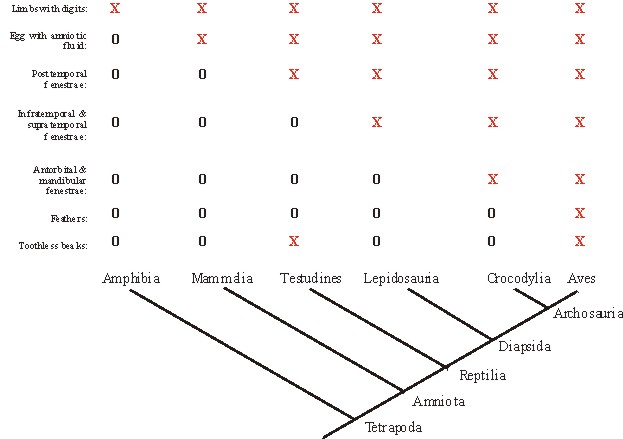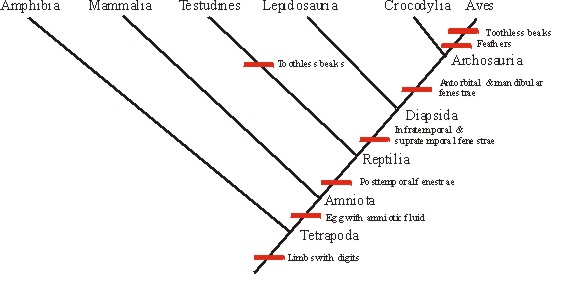GEOL 104 Dinosaurs: A Natural History
Fall Semester 2000
Systematics II
Cladograms represent a way of graphically portraying the evolutionary relationships of
organisms. How are these relationships discovered?
Because evolution is descent with modification, ancestral species will pass on
evolutionary novelties that they developed, as well as primitive features developed in even
earlier ancestors. These features can be morphological, behavioral, molecular (DNA), etc. (however,
for paleontological purposes morphological are best).
Anatomical (and behavioral, and genetic) features that are similar between taxa are said
to be shared characters. There can be three different reasons these features are
shared:
- Synapomorphies (shared derived characters), representing new
specializations evolved in the most recent common ancestor of the ingroup;
- Symplesiomorphies (shared primitive characters), representing common
homologies found in the ingroup and some of the more distantly related outgroups;
- Homoplasies, representing similarities which are not inherited directly from a
common ancestor but are instead convergences (evolved separately in independent lineages)
or reversals (evolved from a derived condition back to the primitive condition)
Cladograms are constructed by sorting out the simplest (most parsimonious)
arrangement of shared derived characters. For example, below is a cladogram of living terrestrial
vertebrates, and a list of characters above. In that list, a red "X" represents
the presence of that feature in the taxon, and a black "0" represents the absence
of that feature.

So, in the diagram above:
- Limbs with digits are present in all the terminal taxa;
- Eggs with amniotic fluid is absent in amphibians, but present in mammals, turtles,
lepidosaurs, crocodilians, and birds (or, in other words, is absent in Amphibia but present in Amniota);
- Posttemporal fenestrae are absent in amphibians and mammals, but present in reptiles;
- Etc.
Or, to put it another way:
Limbs with digits is a synapomorphy for Tetrapoda, but a symplesiomorphy
for all its subclades (e.g., Amphibia, Amniota, Mammalia, Reptilia, etc.)
Eggs with amniotic fluid is a synapomorphy for Amniota, but a symplesiomorphy for
all of its subclades (e.g., Mammalia, Reptilia, Testudines, etc.)
Toothless beaks is a homoplasy (i.e., a convergence) between Testudines
and Aves, as the forms intermediate between them (lepidosaurs, crocodilians) retain the
primitive condition of having teeth.
Another particular kind of character is an autapomorphy, a feature found in only
one of the terminal taxa in an analysis.
In the above cladogram, the presence of feathers is an autapomorphy of Aves; no
other living vertebrate has feathers. (However, WITHIN Aves, feathers would be
a symplesiomorphy).
Another, simpler way of drawing the above cladogram is to indicate the characters on the
braches where they would have originated:

In the cladogram above, the characters evolved on the branch where the red line indicate:
Limbs with digits evolved in the common ancestor of all tetrapods, and is a
synapomorphy for Tetrapoda;
Eggs with amniotic fluid evolved in the common ancestor of all amniotes, and is
a synapomorphy for Amniota;
Etc.
Note that even the synapomorphies shown here can be modified through additional evolution
at any point further up in the cladogram:
- Although some modern mammals (the monotremes: platypi and echidnas) lay shelled amniotic
eggs, most (marsupials and placentals) have internalized these tissues and so do not lay
eggs outside the body: this internalization is a synapomorphy of a group containing
marsupials and placentals, but not monotremes.
- Modern snakes lack limbs with digits: this transformation is a sort of homoplasy
(specifically, a reversal to the ancestral vertebrate condition), since ancestral snakes
and their outgroups (other lizards, archosaurs, turtles, mammals, amphibians) all have limbs
with digits
To Next Lecture.
To Previous Lecture.
To Syllabus.


